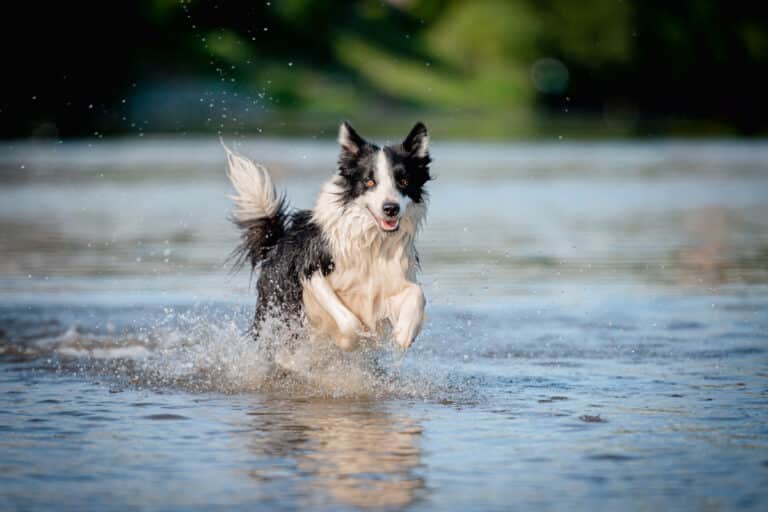The seasons may change. But your Border Collie’s insatiable need to have fun outdoors will not. And the dip or the rise in temperature outside will not stop them from doing so.
But this independent thinker may not make the best decisions all the time. Sometimes, they do not know when to stop playing even if the weather is getting unforgiving.
So as their fur parent, you should know when to take them indoors. This knowledge could potentially save your Border Collie from dangerous medical conditions. Or even worse, death.
Do Border Collies Do Well in Cold Weather?
With their double coat, Border Collies can tolerate cold weather quite well. They prepare for their winter in fall, shedding off their thinner and lighter coat. The coat that grows back is fuller and thicker to provide insulation from the cold.
Although they have this, their coat may not be enough for extreme temperatures. This also does not provide enough warmth from wet winters.
And even if your Border Collie can frolic around in the snow, they cannot stay too long outdoors. So you should not let them sleep outside to avoid hypothermia.
Each Border Collie is an individual and they have varying cold tolerances. Three factors contribute to this, all discussed below.
Age
Younger and older Border Collies need a bit more help keeping warm during wintertime. Puppies still do not have their adult coat, which has better insulation. Senior Border Collies also find it harder to regulate their body temperature.
Body Fat
A good layer of fat on your Border Collie’s body will make it easier for them to keep warm. This is a great added insulation to their double coats.
So if your Border Collie has some extra fat, they will do better during winter. And if they are on the thin side, they may need to snuggle up in a warm blanket for comfort.
Health
If your furry friend has any health issues, they will find it hard to regulate their body temperature. For example, the cold weather can constrict their muscles. This is painful for Border Collies who have arthritis, especially for seniors.
Other medical conditions, like diabetes, can also be a problem during winter.
How Much Cold Can a Border Collie Tolerate?
In general, Border Collies can tolerate temperatures up to 32 degrees F (0 degrees C). But this will still depend on your Border Collie’s tolerance and the weather. This is only a guide that you can follow to make sure your Border Collie is fine to play outside.
There are a few factors that affect your Border Collie’s tolerance for the cold. This includes their age, health condition, and their body fat. But other than that, you should also consider the conditions outside.
If it is windy or rainy outside, even temperatures above 32 degrees F (0 degrees C) can be too cold for them. But if the weather is sunny, dry, or not windy, they may tolerate temperatures lower than this.
So when taking them outdoors in the winter, you should regularly check up on your Border Collie. They cannot tell you how they feel, so watch out for their body language.
If they begin to shiver, it is time to take them indoors and keep helping them warm up.
Do Border Collies Like Snow?
Neither snow nor the cold weather will stop your Border Collie from having a good time. They love to play around in the snow as long as they are healthy and are the right age. So do not worry about taking them out for a stroll, this breed knows how to have fun wherever and whenever.
Do Border Collies Get Cold Easily?
This outdoorsy breed handles cold weather better than indoor dogs. They have thick coats that keep them warm, letting them frolic without a care in the snow. But Border Collies are still not immune to getting cold, which is why you need to keep an eye on them.
Here are some signs that your Border Collie is getting cold:
- Shivering or Shaking
- Barking
- Tucked Tail
- Hunching
- Frequent Paw Lifting
- Reluctance to Move
Once you see any of these signs, take your Border Collie indoors immediately. Give them some blankets, move their bed near the heater, or give them a heating pad.
If you do not take them indoors as soon as you see one of these, this can lead to hypothermia. This is a medical emergency so you should act right away. Not taking immediate action can lead to many serious issues including death.
Given the grave effects of hypothermia, here are the signs that you should watch out for:
- Lethargy
- Weakness
- Dizziness
- Slow and Shallow Breathing
- Loss of Consciousness
- Dilated and Fixed Pupils
- Stiffened Body
How to Keep Border Collies Warm
There are many ways you can keep your Border Collie warm during the cold weather. So do not limit them to a warm and fluffy blanket! Even the simplest things can bring your Border Collie much comfort during winter.
A Warm Shelter
This is less of an issue if your Border Collie lives indoors, where they have access to a heater. But if they live outdoors, you have to put more thought into their shelter.
An insulated and elevated dog house will help to protect them from harsh weather. Make sure to position the door away from the wind and that it has a flap. Any draft inside their shelter could make even mild winters unbearable.
You should also consider getting them a pet heating pad. This will help them keep warm when there are significant drops in temperature at night.
Switch Their Food Bowl
A food bowl made out of stainless steel is not ideal during winter. Metal food bowls get cold quickly and their tongue can get stuck to them. Again, this is especially an issue if they live outdoors.
So consider getting them a ceramic or a plastic food bowl instead. These materials cool slower than stainless steel avoiding the issue above.
You can also invest in a heated pet bowl so they have access to lukewarm water at all times.
Lukewarm Drinking Water
Speaking of lukewarm water, you should not have them drink cold water during winter. But this does not mean that they have to drink warm water too. Lukewarm water will keep them hydrated as it will encourage them to drink more.
Stay Close to Home
Not straying too far from home will help you take immediate action when there is an emergency. The weather is unpredictable and it could get too chilly for your Border Collie to handle.
If they show signs that they are getting cold, you can take them indoors right away. This could potentially save their life since you can get them immediate care.
Keep the Leash on
Your Border Collie may have excellent obedience and recall. But to be on the safe side, keep them on a leash when walking outside during winter.
The weather conditions may be unforgiving. So your Border Collie may lose you if they venture far away from you.
Always Stay Dry
Getting wet is a big issue for your furry friend during winter. If their coat is damp, it will not help them regulate their body temperature. So they can get cold quicker than if they are dry, even if they have a double coat.
So if you are experiencing a wet winter, it is best to keep the fun indoors instead.
Doggy Winter Gear
It is always good to get your Border Collie a dog jacket. If your Border Collie is a healthy adult, bring one with you when you play outdoors. You can wrap them up in one once you see that they are getting cold.
But a dog jacket or coat is crucial if your Border Collie is a puppy or a senior. Dogs of these ages cannot regulate their body temperature well. So they need some help in keeping themselves warm.
Dog boots may not be necessary if they are walking on your property. But it would be best if you made them wear one in public places or on unforgiving terrains.
This protects their paws from getting hurt not only by sharp objects or shards of snow. But it also protects them from snow salt, which can irritate their paws.
Paw Care
During the winter season, you should trim your Border Collie’s paw fur. This prevents ice from forming between their paw pads, causing discomfort.
And before playtime ends, clean their paw pads. This gets rid of dirt and snow that their furry paws may have collected.
Can Border Collies Handle Hot Weather?
Border Collies love to play and bask in the sun. Considering their sunny and lively personality, this is very fitting. But this does not mean that they can have endless fun under the sun.
This double-coated breed sheds its winter coat during spring to make way for summer. But there are other ways that they can regulate their body temperature, like sweating. Dogs only sweat through their noses and paws though, a significant limitation. So they make up for this by panting, but this act is very exhausting.
As you can see, it seems like all odds are against your poor companion.
This is why although they enjoy the sun, you need to keep a watchful eye on them. A healthy adult Border Collie can tolerate this the most. But Border Collies who fit the criteria below find this hard to do:
- Puppies and Older Border Collies
- Border Collies With Health Issues (Heart and Respiratory Problems)
- Overweight or Obese Border Collies
- Border Collies Who Are Not Used to Warm Climates
So be very careful if your Border Collie is any of these. They are more at risk of overheating and heatstroke.
Dehydration is also a big factor that can lead to overheating. This condition is equally dangerous, so you should know its signs:
- Pale and Dry Gums and Nose
- Decreased Skin Elasticity
- Sunken Eyes
- Faster Heart Rate
- Urinating Less
Make sure your Border Collie always has access to clean drinking water during the summer. Especially if they love to get active and if they work on a farm.
What Temperature Is Too Hot for a Border Collie?
Temperatures above 92 degrees F (33 degrees F) may be too hot for your Border Collie to tolerate. But they can tolerate temperatures of 85 degrees F (30 degrees C) well, even if they are playing outside. You have to make sure that they always have access to drinking water and shade for them to cool down.
You only have a few degrees between a comfortable and a dangerous temperature. And a mild heatstroke can swiftly become severe within only a few minutes. This can lead to a medical emergency and can prove to be fatal.
Since this is a serious matter, you should be aware of the signs of overheating:
- Excessive Drooling
- Excessive Panting
- Purple Gums
- Vomiting
- Diarrhea
- High Body Temperature
- Loss of Balance
- Seeming Disoriented
If you see any of these signs, take immediate action. Bring your Border Collie to a shaded area and give them cool water to drink. Then grab a damp towel and put it over your furry friend.
It is best if you take them to the vet too as they may need more help. In severe cases, your Border Collie will need intravenous hydration. So if they have a hard time drinking water or walking, see a vet right away.
How Do I Keep My Border Collie Cool in the Summer?
You have many ways to keep your Border Collie cool when it is hot outside. Keeping this outdoorsy dog indoors the whole day is not possible and they will bug you about it. So this involves working around your schedule with the sun. But that may not be enough. It is not practical for you to wait for the sun to go down all the time. You also have your routine to follow, after all.
So here are your options to keep your furry friend cool during the summertime.
Plan Outdoor Activities
Avoid taking them outdoors when the sun is up and scorching. Instead, have your Border Collie play outside during early mornings or after sunset. These are the cooler parts of the day, so you can avoid any overheating issues.
Do this, especially when walking them around the neighborhood. Walking on hot asphalt can burn your Border Collie’s paws. A more forgiving surface for them to walk on would be the ground or grass.
Give Them Access to Drinking Water and Shade
These two are crucial in keeping your Border Collie cool on a hot day. Remember, dehydration is one of the factors that lead to overheating. So your Border Collie must drink throughout the day.
Providing them with access to shade will help them rest in a cool area. This can be under a tree or you can give them an elevated tent too.
Keep Them Indoors
One of the best ways to keep your Border Collie cool is to let them stay in a cool room indoors. Especially during the hottest times of the day, between 1 PM and 5 PM. So turn on the fan or air conditioning to keep them comfortable.
Cooling Mats, Collars, or Vests
If you do not have air conditioning at home, your Border Collie will benefit a lot from a cooling mat. The good thing with this is that you can take it anywhere. So they can cool down inside your home, outdoors, and even in your car on a road trip.
You can also provide them with a cooling collar. This does a wonderful job of keeping them cool during outdoor fun. Your Border Collie can wear this on walks, runs, or even during hikes.
A cooling vest will also do a good, if not, a better, job at this. For hotter days and more intense activities, you can use this instead of a collar.
Proper Grooming
Something as simple as brushing your Border Collie’s coat will help a ton during summer. When you brush their hair, you are taking away fallen hair. This creates more space for air to touch your Border Collie’s skin, keeping them cool.
This also helps to get rid of any matting, which can prevent proper airflow.
Proper Paw Care
This may not necessarily help to cool down your Border Collie. But giving their paws proper protection can prevent any discomfort. A paw balm or even dog boots can prevent their paws from burning, whether the surface they walk on is too hot or too cold.
Why Does My Border Collie Love the Sun?
Like humans, basking in the sun feels nice for your Border Collie. They also enjoy other benefits by taking a snooze under the sun, which are all discussed below.
The Sun Feels Relaxing
Dogs love laying in the sun as much as humans do. So one of your Border Collie’s favorite snoozing spots may be near a window. The warmth of the sun feels like your comforting hug to them.
The Sun Improves Their Mood
When your Border Collie is under the sun, its body produces serotonin, a happy hormone. So the sunlight can make your Border Collie an even happier pup!
The Sun Helps Them Regulate Their Body Temperature
On a chilly day, it is natural for your furry friend to look for a warm spot. They can snuggle up in their blankets, but some prefer the warmth of the sun near the window.
The Sun Is a Source for Vitamin D
Like you, your Border Collie can get vitamin D from the sun. But the way they get it from the sun is not like humans.
When you sunbathe, the UV rays create vitamin D by breaking down the oils in your skin. And after production, your skin absorbs it.
So with your Border Collie’s fur in the way, how do they get their dose of vitamin D?
They still produce this vitamin on their fur, but their skin does not absorb it. Instead, your Border Collie licks their coat so they ingest the vitamin D.
Vitamin D is a crucial part of your Border Collie’s diet. Your Border Collie needs it to absorb calcium, an essential mineral for strong bones. It also helps with the health of their muscle, nervous system, and immune system.
But your Border Collie gets most of their vitamin D from their diet. So you need to be cautious about letting them stay too long under the sun. Moderation is the key. Otherwise, this can lead to heatstroke, sunburn, and in severe cases, skin cancer.
So make sure you give your Border Collie a time out from the sun too. Have them wear doggy sunscreen, too, before they bask in the sun. Do not use human sunscreens as they often have zinc oxide, which is toxic to your canine friend.
Apply their sunscreen on areas with a greater risk of burning. This includes their nose, groin, and belly. The fur on their belly is often thin and sparse and is lighter in color. All these make the area more prone to sun damage if they expose it to the sun too much.








